-

人教版新课标小学数学二年级下册两位数加减两位数(口算)说课稿3篇
二、说教学目标1、结合具体情境进一步理解加减法的意义,能正确口算得数是百以内数的两位数加减法。2、能利用所学知识,在教师的指导下提出并解决简单的实际问题,了解同一问题可以用不同的方法解决。3、经历与他人交流各自计算方法的过程,体验解决问题策略的多样性,感受学数学、用数学的乐趣。三、说教法、学法教法:为了使学生掌握好百以内的两位数加减两位数的口算这部分知识,达到以上教学目的,突破以上教学重难点,我采用了迁移法、引导法、讲解法、联系法、自主探索法来进行教学。学法:通过本课的学习,使学生学会利用旧知构建新知的方法、合作探究的方法,调动学生主动探索的积极性。四、说教学过程(一)创设情景、导入新课1、谈话:同学们,大千世界无奇不有。我们所处的人类的社会是由一个个担任不同工作的人所组成的,而和我们生活密切相关的蜜蜂也跟人类一样,它们生活在一个蜜蜂王国里,今天我们就一起到那里了解一下蜜蜂的生活吧。
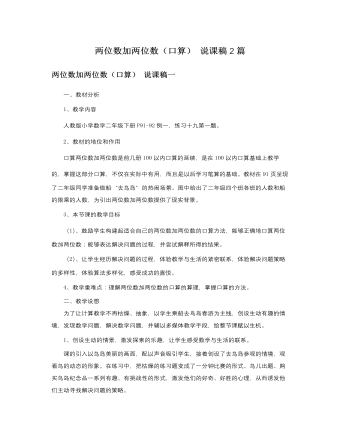
人教版新课标小学数学二年级下册两位数加两位数(口算)说课稿2篇
(四)、课堂总结、体验成功引导学生对所学知识、学习方法、学习结果、情感等进行全面总结,让学生体验学习的成功感,同时,进一步系统、完善知识结构。总之,本课的教学设计力求体现“以学生为本”的教学理念,具体体现在以下几个方面:(一)、创设生动的情景,激发探索的乐趣,让学生感受数学与生活的联系。课的引入以一幅学生经常接触的,喜闻乐见的购买玩具这一题材为切入点。在练习设计中,改变枯燥抽象的数字计算练习,选取了一组寓有童趣的素材。它们以丰富多彩的呈现方式深深地吸引着学生,使他们认识到现实生活中蕴含着大量的数学信息,使学生感到有趣、有挑战性,激发他们好奇,好胜的心理,从而诱发他们去主动寻求解决问题的策略,同时体验到数学与生活的联系。
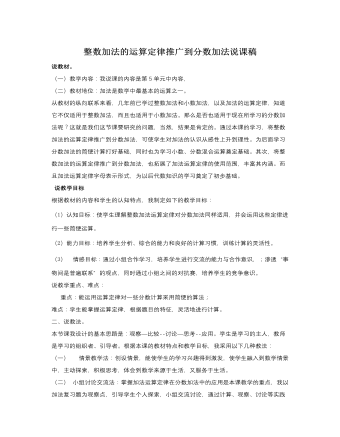
人教版新课标小学数学五年级下册整数加法的运算定律推广到分数加法说课稿
(一)教学内容:我说课的内容是第5单元中内容,(二)教材地位:加法是数学中最基本的运算之一。从教材的纵向联系来看,几年前已学过整数加法和小数加法,以及加法的运算定律,知道它不仅适用于整数加法,而且也适用于小数加法。那么是否也适用于现在所学习的分数加法呢?这就是我们这节课要研究的问题,当然,结果是肯定的。通过本课的学习,将整数加法的运算定律推广到分数加法,可使学生对加法的认识从感性上升到理性。为后面学习分数加法的简便计算打好基础,同时也为学习小数、分数混合运算奠定基础。其次,将整数加法的运算定律推广到分数加法,也拓展了加法运算定律的使用范围,丰富其内涵。而且加法运算定律字母表示形式,为以后代数知识的学习奠定了初步基础。
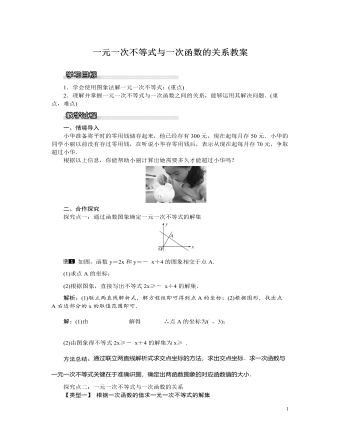
北师大初中八年级数学下册一元一次不等式与一次函数的关系教案
解析:先利用正比例函数解析式确定A点坐标,然后观察函数图象得到,当1<x<2时,直线y=2x都在直线y=kx+b的上方,于是可得到不等式0<kx+b<2x的解集.把A(x,2)代入y=2x得2x=2,解得x=1,则A点坐标为(1,2),∴当x>1时,2x>kx+b.∵函数y=kx+b(k≠0)的图象经过点B(2,0),即不等式0<kx+b<2x的解集为1<x<2.故选C.方法总结:本题考查了一次函数与一元一次不等式的关系:从函数的角度看,就是寻求使一次函数y=ax+b的值大于(或小于)0的自变量x的取值范围;从函数图象的角度看,就是确定直线y=kx+b在y轴上(或下)方部分所有的点的横坐标所构成的集合.三、板书设计1.通过函数图象确定一元一次不等式的解集2.一元一次不等式与一次函数的关系本课时主要是掌握运用一次函数的图象解一元一次不等式,在教学过程中采用讲练结合的方法,让学生充分参与到教学活动中,主动、自主的学习.
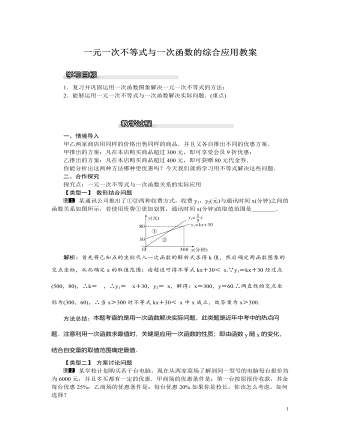
北师大初中八年级数学下册一元一次不等式与一次函数的综合应用教案
解析:(1)根据题设条件,求出等量关系,列一元一次方程即可求解;(2)根据题设中的不等关系列出相应的不等式,通过求解不等式确定最值,求最值时要注意自变量的取值范围.解:设购进A种树苗x棵,则购进B种树苗(17-x)棵,(1)根据题意得80x+60(17-x)=1220,解得x=10,所以17-x=17-10=7,答:购进A种树苗10棵,B种树苗7棵;(2)由题意得17-x172,所需费用为80x+60(17-x)=20x+1020(元),费用最省需x取最小整数9,此时17-x=17-9=8,此时所需费用为20×9+1020=1200(元).答:购买9棵A种树苗,8棵B种树苗的费用最省,此方案所需费用1200元.三、板书设计一元一次不等式与一次函数关系的实际应用分类讨论思想、数形结合思想本课时结合生活中的实例组织学生进行探索,在探索的过程中渗透分类讨论的思想方法,培养学生分析、解决问题的能力,从新课到练习都充分调动了学生的思考能力,为后面的学习打下基础.
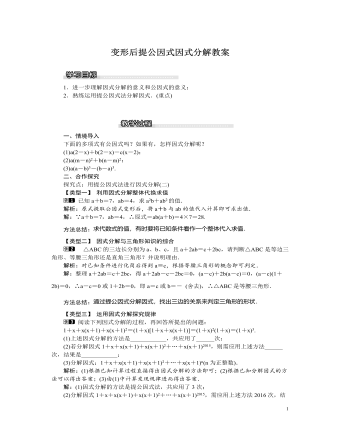
北师大初中八年级数学下册变形后提公因式因式分解教案
(3)分解因式:1+x+x(x+1)+x(x+1)2+…+x(x+1)n(n为正整数).解析:(1)根据已知计算过程直接得出因式分解的方法即可;(2)根据已知分解因式的方法可以得出答案;(3)由(1)中计算发现规律进而得出答案.解:(1)因式分解的方法是提公因式法,共应用了3次;(2)分解因式1+x+x(x+1)+x(x+1)2+…+x(x+1)2015,需应用上述方法2016次,结果是(1+x)2015;(3)1+x+x(x+1)+x(x+1)2+…+x(x+1)n=(1+x)n+1.方法总结:解决此类问题需要认真阅读,理解题意,根据已知得出分解因式的规律是解题关键.三、板书设计1.提公因式分解因式的一般步骤:(1)观察;(2)适当变形;(3)确定公因式;(4)提取公因式.2.提公因式法因式分解的应用本课时是在上一课时的基础上进行的拓展延伸,在教学时要给学生足够主动权和思考空间,突出学生在课堂上的主体地位,引导和鼓励学生自主探究,在培养学生创新能力的同时提高学生的逻辑思维能力.
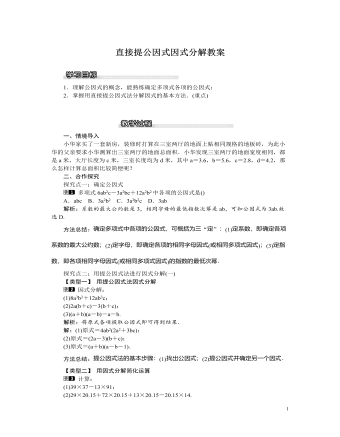
北师大初中八年级数学下册直接提公因式因式分解教案
解析:(1)首先提取公因式13,进而求出即可;(2)首先提取公因式20.15,进而求出即可.解:(1)39×37-13×91=3×13×37-13×91=13×(3×37-91)=13×20=260;(2)29×20.15+72×20.15+13×20.15-20.15×14=20.15×(29+72+13-14)=2015.方法总结:在计算求值时,若式子各项都含有公因式,用提取公因式的方法可使运算简便.三、板书设计1.公因式多项式各项都含有的相同因式叫这个多项式各项的公因式.2.提公因式法如果一个多项式的各项有公因式,可以把这个公因式提到括号外面,这种因式分解的方法叫做提公因式法.本节中要给学生留出自主学习的空间,然后引入稍有层次的例题,让学生进一步感受因式分解与整式的乘法是逆过程,从而可用整式的乘法检查错误.本节课在对例题的探究上,提倡引导学生合作交流,使学生发挥群体的力量,以此提高教学效果.
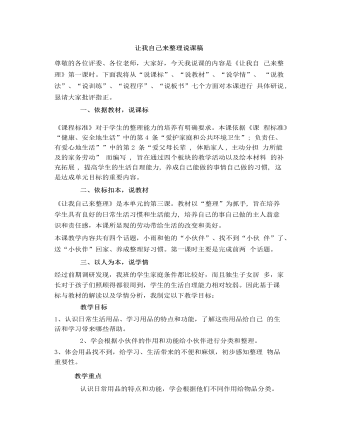
人教部编版道德与法制二年级上册家乡物产养育我说课稿
导语:同学们,你们瞧!我们的水东家乡不仅山美、水美、人美而且还有丰富的物产资源。看到这些,你们的心里在想些什么呢?你们想用什么形式来赞美我们的家乡呢?1、小组同学讨论。(诗歌表演、歌曲表演、赞美的话、简笔画 )3、请同学代表表演。 (五)、总结:同学们,短短的旅行即将结束,你是不是也像老师一样意犹未尽呢?在这节课上,我们不仅对家乡多了一份了解,而且又多了一份爱,增添了一份自豪。你们那些发自肺腑的言语感动着我们在座的每一位老师与同学。今天,我们为自己的家乡感到自豪;希望未来,家乡为你们的成长感到自豪。最后,让我们在优美的歌声中,再一次欣赏一下我们美丽的家乡。让我们永远记住这个千年古镇——生我、养我、爱我、育我美丽的水东家乡吧!
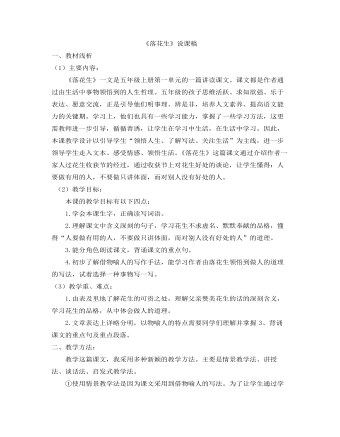
部编人教版五年级上册《 落花生》说课稿
(1)主要内容:《落花生》一文是五年级上册第一单元的一篇讲读课文。课文都是作者通过由生活中事物领悟到的人生哲理。五年级的孩子思维活跃、求知欲强、乐于表达、愿意交流,正是引导他们明事理、辨是非,培养人文素养、提高语文能力的关键期。学习上,他们也具有一些学习能力,掌握了一些学习方法,这更需教师进一步引导,循循善诱,让学生在学习中生活,在生活中学习。因此,本课教学设计以引导学生“领悟人生、了解写法、关注生活”为主线,进一步领导学生走入文本、感受情感、领悟生活。《落花生》这篇课文通过介绍作者一家人过花生收获节的经过,通过收获节上对花生好处的谈论,让学生懂得:人要做有用的人,不要做只讲体面,而对别人没有好处的人。(2)教学目标:本课的教学目标有以下四点:1.学会本课生字,正确读写词语。
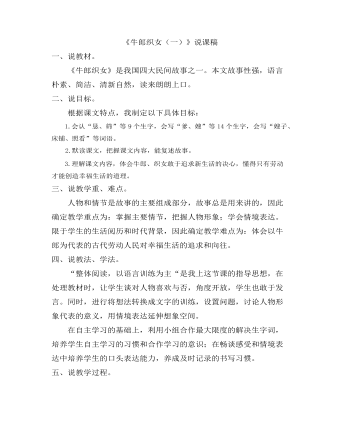
部编人教版五年级上册《牛郎织女(一)》 说课稿
三、说教学重、难点。人物和情节是故事的主要组成部分,故事总是用来讲的,因此确定教学重点为:掌握主要情节,把握人物形象;学会情境表达。限于学生的生活阅历和时代背景,因此确定教学难点为:体会以牛郎为代表的古代劳动人民对幸福生活的追求和向往。四、说教法、学法。“整体阅读,以语言训练为主“是我上这节课的指导思想,在处理教材时,让学生谈对人物喜欢与否,角度开放,学生也敢于发言。同时,进行将想法转换成文字的训练,设置问题,讨论人物形象代表的意义,用情境表达延伸想象空间。
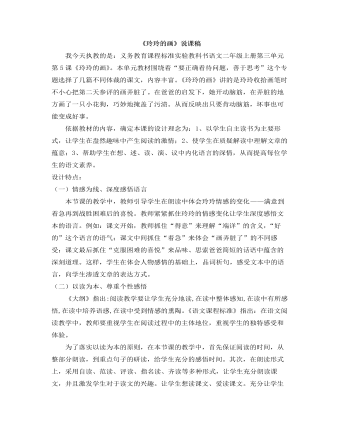
部编人教版二年级上册《玲玲的画》说课稿
依据教材的内容,确定本课的设计理念为:1、以学生自主读书为主要形式,让学生在盎然趣味中产生阅读的激情;2、使学生在质疑解读中理解文章的蕴意;3、帮助学生在想、述、读、演、议中内化语言的深情,从而提高每位学生的语文素养。设计特点:(一)情感为线、深度感悟语言本节课的教学中,教师引导学生在朗读中体会玲玲情感的变化——满意到着急再到战胜困难后的喜悦。教师紧紧抓住玲玲的情感变化让学生深度感悟文本的语言。例如:课文开始,教师抓住“得意”来理解“端详”的含义,“好的”这个语言的语气;课文中间抓住“着急”来体会“画弄脏了”的不同感受;课文最后抓住“克服困难的喜悦”来品味、思索爸爸简短的话语中蕴含的深刻道理。这样,学生在体会人物感情的基础上,品词析句,感受文本中的语言,向学生渗透文章的表达方式。
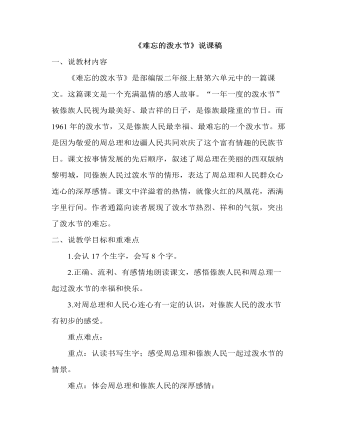
部编人教版二年级上册《难忘的泼水节》说课稿
二、说教学目标和重难点1.会认17个生字,会写8个字。2.正确、流利、有感情地朗读课文,感悟傣族人民和周总理一起过泼水节的幸福和快乐。3.对周总理和人民心连心有一定的认识,对傣族人民的泼水节有初步的感受。重点难点:重点:认读书写生字;感受周总理和傣族人民一起过泼水节的情景。难点:体会周总理和傣族人民的深厚感情;能用“一手……一手……”“一边……一边”说话。三、说设计理念和教法、学法怎么才能突出重点,突破难点,达到以上的教学目标呢?下面我来谈谈设计理念:1.以读为本:新课标指出:“阅读是学生的个性化行为,不应以教师的分析来代替学生的阅读实践。”好文章要三读:初读读通——细读读懂——品读读美。文本是连接读者和作者的桥梁,只有让学生朗读课文,触摸文本,发挥自己独特的心理体验,情感体验,在读中理解,在读中感悟。
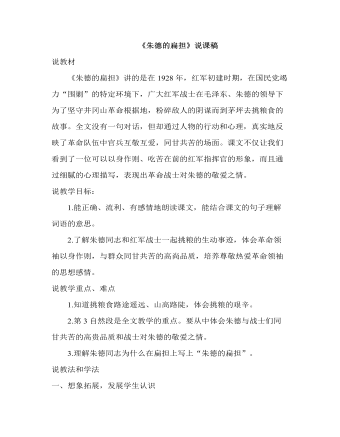
部编人教版二年级上册《朱德的扁担》说课稿
《语文课程标准》指出:“语文课程丰富的人文内涵对人们的精神领域的影响是深广的,学生对语文材料的反映往往也是多元的。”启发学生借助教材展开想象,并通过换位思考,体验人物内心,从吸收至倾吐,发展学生的语言,发展学生的思维,从而切实提高学生的认识,指导他们的生活。首先在教学过程中引导学生主动思维,激发学生的情感,从自己的身边去发现,去对比,加强对当时革命状况的了解,从而引发对革命事业崇敬之情。其次在教学的过程中,教师创设这样一个情境,把学生置身于故事所在的背景中,使得学生把自己当作是故事中的一员来参与,参与其中的艰辛,参与其中的心理过程,这样不但有助于教学的开展,而且也可以让学生能够更加的感同身受,激发学生对革命领导人的尊敬与热爱。
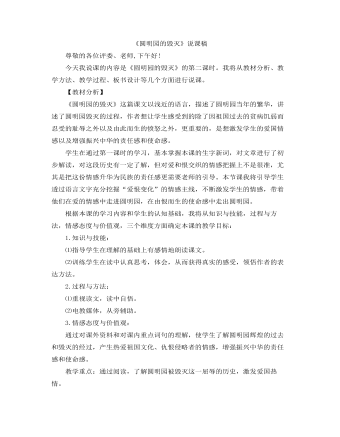
部编人教版五年级上册《 圆明园的毁灭》说课稿
【教材分析】《圆明园的毁灭》这篇课文以浅近的语言,描述了圆明园当年的繁华,讲述了圆明园毁灭的过程,作者想让学生感受到的除了因祖国过去的贫病饥弱而忍受的耻辱之外以及由此而生的愤怒之外,更重要的,是想激发学生的爱国情感以及增强振兴中华的责任感和使命感。 学生在通过第一课时的学习,基本掌握本课的生字新词,对文章进行了初步解读,对这段历史有一定了解,但对爱和恨交织的情感把握上不是很准,尤其是把这份情感升华为民族的责任感更需要老师的引导。本节课我将引导学生透过语言文字充分挖掘“爱恨变化”的情感主线,不断激发学生的情感,带着他们在爱的情感中走进圆明园,在由恨而生的使命感中走出圆明园。根据本课的学习内容和学生的认知基础,我将从知识与技能,过程与方法,情感态度与价值观,三个维度方面确定本课的教学目标:
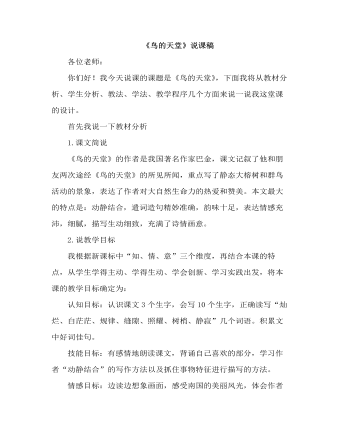
部编人教版五年级上册《鸟的天堂》说课稿
二、学生分析五年级是小学生知识、能力、情感价值观形成的关键时期,他们对自我、他人、家庭、社会有了一些浅显的认识,养成了一定的好的学习习惯,有了一定的阅读能力,读书提问的能力。因本课的阅读性、活动性、实践性较强,绝大部分学生对于如何在阅读活动中边读边想的方法不明确,在实践中应怎想,想什么不够明晰。下面为了讲清重点、难点,使学生能达到本节设定的教学目标,我再从教法和学法上谈谈。三、说教法在教学中,我们不仅要让学生“知其然”而且要让学生“知其所以然”,科学合理的教学方法,能使教学效果事半功倍,达到教与学的和谐完美统一。为了达到目标,突出重点,突破难点,解决疑难,我具体运用了以下几种教法,情景设置法——主要是激发学生情感,引起他们的学习兴趣,讲授法——充分发挥教师的主导作用,系统地向学生传授知识。点拨法——是教师在学生讨论的过程中,伺机点拨,让他们展开联想和想象,拓展思路。在以上几种教法中点拨法是最重要的一种方法。
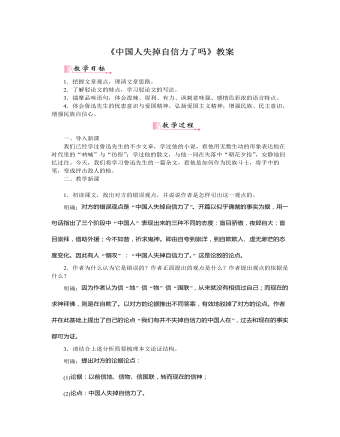
部编版语文九年级上册《中国人失掉自信力了吗》教案
一、导入新课我们已经学过鲁迅先生的不少文章,学过他的小说,看他用无数生动的形象表达他在时代里的“呐喊”与“彷徨”;学过他的散文,与他一同在失落中“朝花夕拾”,安静地回忆过往。今天,我们将学习鲁迅先生的一篇杂文,看他是如何作为民族斗士,将手中的笔,变成抨击敌人的枪。二、教学新课目标导学一:学习驳论,理清思路1.初读课文,找出对方的错误观点,并说说作者是怎样引出这一观点的。明确:对方的错误观点是“中国人失掉自信力了”。开篇以似乎确凿的事实为据,用一句话指出了三个阶段中“中国人”表现出来的三种不同的态度:盲目骄傲,夜郎自大;盲目崇拜,借助外援;今不如昔,祈求鬼神。即由自夸到崇洋,到自欺欺人、虚无渺茫的态度变化。因此有人“慨叹”:“中国人失掉自信力了。”这是论敌的论点。
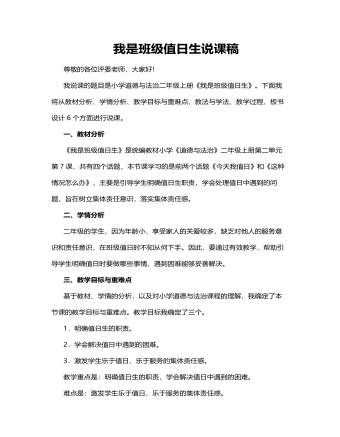
人教部编版道德与法制二年级上册我是班级值日生说课稿
学生阅读教材第26页的四幅图画,反思日常生活中自己的一些做法,然后在小组内交流,再全班交流展示,教师相机引导、板书。设计意图:对日常生活中自己值日的思考,激发学生对值日生职责的认同感。活动二:解决值日中遇到的难题学生阅读教材第27页的四幅图,思考自己在值日中遇到过什么困难,然后全班交流,学生畅所欲言,教师引导学生共同解决。设计意图:针对学生值日中真实的困惑进行引导和解决,提高学生的责任意识、道德能力。活动三:我是今天的值日生课件出示儿歌《我是今天的值日生》。学生先自己读一读,全班再齐读。设计意图:再次认识值日生的职责。环节三:课堂小结,内化提升学生谈一谈学习本节课的收获,教师相机引导。设计意图:梳理总结,体验收获与成功的喜悦,内化提升学生的认识与情感。环节四:回归生活,拓展延伸制作班级值日生的表格,记录自己今后做值日的情况。设计意图:将课堂所学延伸到学生的日常生活中,有利于落实行为实践。
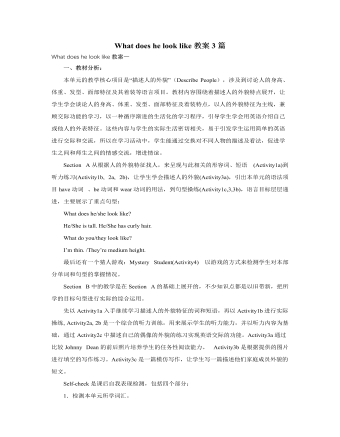
人教版新目标初中英语七年级下册What does he look like教案3篇
所需要用到的句子:Who is that?That is Jack. I like him.Why do you like him?I like him because he is interesting.Task 4: 设计理想中的人类Step one: 设计理想中的人类的外貌。把全班同学分成若干小组,学生可以边说边在纸上画出他们的模样。Step two: 设计理想中人类的性格。学生们可以把那些能描述性格的单词写在图画的旁边。Step three: 每组选出一名同学,其他同组同学提问,他作简单回答,并说明原因。所需用到的句子:What does he or she look like?He or she ...What is he or she like?He or she is ...Why?Because ...Task 5: 挑战性活动调查性格是天生的还是后天形成的,让每个同学回家去调查一下自己成长过程中性格是否有变化,具体是怎样的,为什么会这样? Teaching Aims:1. Enable students to have a general understanding of how to talk about people's physical appearance.2. Enable students to tackle some essential vocabularies and patterns about describing people. Provide them with necessary skills and methods.3. Create various chances for students to describe the persons they're familiar with, such as classmates, family members, teachers, idols, etc.
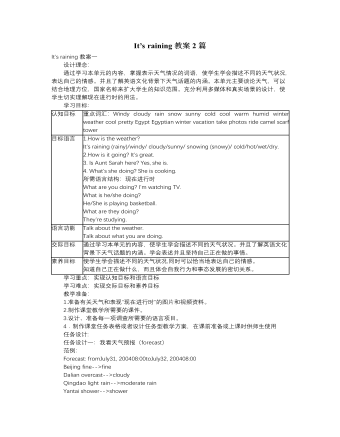
人教版新目标初中英语七年级下册It’s raining教案2篇
1 Each group choose one place to describe and what you are doing in it Choose one place, and describe what they are doing 2 Move around the room and give suggestions Talk about it and write it down 3 Ask one to show their works and act it Choose one of each group to make a report 4 Evaluate the best group and the best reporter Choose the best one Homework Ask your friends their ideal place and write about it教学反思:新课程标准中强调学生在课堂中的主体地位,在综合课中他们的主体地位就更加突出。在各个活动中给不同程度的学生不同层次的任务,让各层面的学生都有表现发挥的机会,从而产生对英语的兴趣。使用照片图片多媒体来辅助教学,效果更好。同时让了解其他国家风景,风俗的同学介绍ideal place,增加学生的背景知知识,实现跨学科交流的目的。教案点评:采用任务型教学模式,在各个活动中给不同程度的学生不同层次的任务,让各层面的学生都有表现发挥的机会,从而产生对英语的兴趣。使用照片图片多媒体来辅助教学,效果更好。让了解其他国家风景,风俗的同学介绍ideal place,增加学生的背景知识,实现跨学科交流的目的。
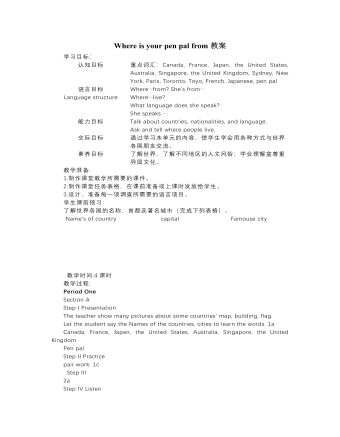
人教版新目标初中英语七年级下册Where is your pen pal from教案
2.1Match the country with the language.Step II Reading3a? let the students read the letter fast and answer the questions.? Let the students ask more questions about the letter as possible as the can.Step III Writing3b.Step IV. Pairwork2cStep V Listening2a, 2bStep V. HomeworkExercises book(1) P3Exercises book (2) P3Period FourStep I . Dictate the words and sentences in Unit1.Step II. Self-checkStep III. Check the answers for Exercises book in the unit.Step IV. Home workRevise and preparation for unit 2.教学反思:通过本单元的学习,学生基本可以谈论人们的国籍,居住城市及其所说的语言,通过书信方式去介绍自己并寻找笔友。但在涉及到国外的一些城市时,学生对这方面的知识相对欠缺,能介绍的城市并不多,也反应出学生课前预习不充分,这跟学生学习条件也有关,大多数学生无法通过网络获取所需信息。因此,在以后的教学中要多指导学生通过计算机网络获取信息,拓宽知识面。





















